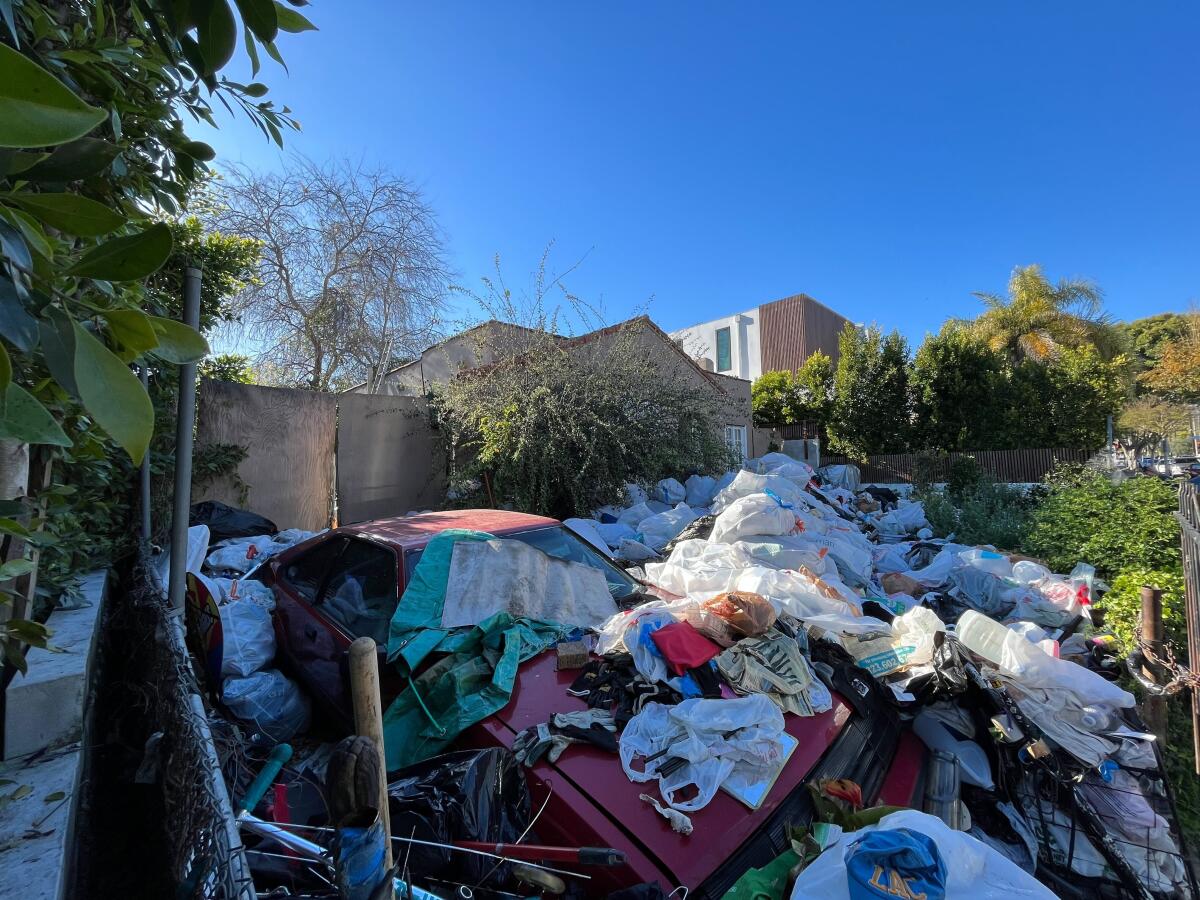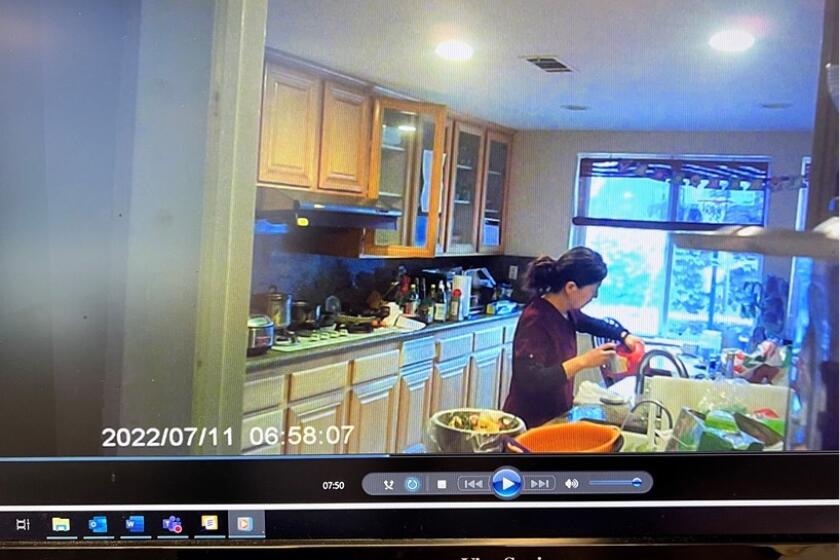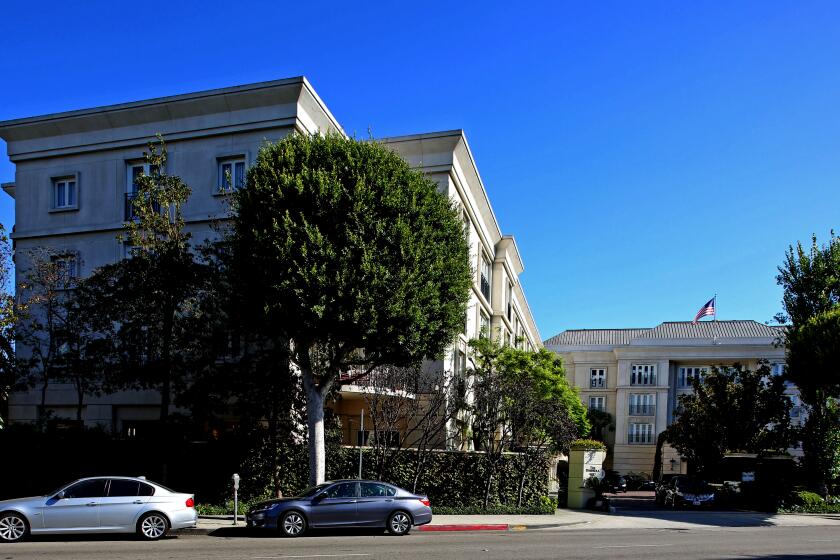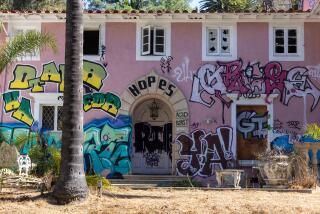Trash outside L.A. home draws complaints, the producer of ‘Hoarders’ — and now Mayor Bass

For years, mounds and mounds of trash have surrounded a Spanish bungalow in Los Angeles’ Fairfax neighborhood.
The frontyard holds hundreds of white trash bags stacked 5 to 6 feet high. The bags are joined by a tangle of buckets and accumulated debris that includes shoes, scooters, empty jugs, newspapers, Levi’s jeans and old Parliament cigarette cartons.
The lawn is not visible. A short metal fence cloaked in ivy blocks off the property. The moat of trash in the yard reaches the driveway, encasing a red Toyota Corolla Twin Cam in crumpled tarps, coat hangers, broom handles, coffee cups, more newspapers and more plastic bags.
Nearby, an old downspout has been fashioned into a sign with handwritten instructions to mail carriers: “Deposit U.S. mail here,” with an arrow pointing to a bucket on the ground.
For as long as they can remember, residents in this stretch of Martel Avenue just south of Melrose have complained to L.A. city officials about the yard’s overgrown vegetation and its mounds of trash and junk.
Dr. Yue “Emily” Yu, charged with poisoning Dr. Jack Chen with Drano, loses visitation with their two children after a school therapist shares their daughter’s reports of abuse.
Since July, the Department of Building and Safety has fielded more than a dozen complaints related to trash and improper storage at the property, according to city records. The complaints remain under investigation, but in November the city ordered the homeowner to comply with its cleanup demands.
With compliance not in sight as the heaps of trash remain, complaints ratcheted up this week, triggered in part by a post on Nextdoor and a report from KTLA on what it called L.A.’s “trash house.” The TV station broadcast aerial footage on Monday of the packed backyard.
“It’s a fire hazard. It’s filthy,” said Miriam Kosberg, whose family has owned the property directly behind the house since 1955. “There’s garbage all the way up to the back fence,” she added, gesturing behind her family’s property.
Kosberg said she and her family hear the sounds of animals in the backyard and believe the swarm of mosquitoes in their yard is due to standing water and other detritus next door.
“It’s been like that for years,” she lamented. Eventually, their family built a wall in their backyard to fortify their property.
On Wednesday, Mayor Karen Bass traveled to the property and spoke to reporters, declaring, “This is a public health emergency.”
Standing beside Councilwoman Katy Yaroslavsky, who represents the Fairfax neighborhood, Bass said, “Both of us, as you know, are new. I am tracking this from last night to find out where complaints were lodged and what happened in the process.”
A neighbor of 22 years told The Times, “It’s unsanitary.” The woman spoke on the condition of anonymity, citing a fear of online harassment.
She and other neighbors said one downstream effect of the heaps of garbage is vermin. They believe there are disproportionate numbers of rats and mice in the area. Security cameras have picked up images of rats prancing on retaining walls, neighbors say.
The woman said she has complained about the property since the early 2000s.
“We are fed up, but we’re compassionate,” she said. “In a perfect world, [the homeowner] gets help and someone helps make his environment nicer for him.”
Raymond Gaon has owned the two-bedroom bungalow since the mid- 1990s, according to public records. The Times could not reach Gaon for comment.
Gaon’s frontyard and its debris were long shrouded in a phalanx of tall plants, bushes and large trees.
In 2014, the city Department of Building and Safety ordered him to remove garbage and debris, clear his driveway, remove overgrown vegetation and stop using his yard as open storage.
Three years later, the city charged him with two misdemeanor criminal counts of failure to comply with an order and failure to maintain his property. But the case was dismissed in 2019 “in the furtherance of justice.” Around that time, conditions at the property had improved noticeably.
Exterior shots of the front of the home from around 2018 and 2019 on Google Maps show the front yard was well-kept, although plywood obscured the backyard and any debris there.
Jonathan Fromen, a developer and contractor who built a house next door to Gaon’s and is building another home on the same street, said he’d gotten to know Gaon and his sister over the years. Gaon is often seen collecting bottles and other waste from trash cans on Melrose Avenue.
“He’s a super nice guy, and sweet,” Fromen said.
Fromen recalled being ecstatic around 2018 and 2019 when he saw Gaon’s yard was being cleaned up.
“It was fantastic for us,” he said. He and his crew even assisted in clearing up the property. There were “cars, animals, birds in cages,” he recalled.
At one point, tow trucks came to haul away cars from the site, he said.
But in the last two years, rubbish has been accumulating again.
A spokesperson for Yaroslavsky said Tuesday that her office was working with the Department of Building and Safety and the city attorney to address concerns.
Fromen said he’d offered to buy Gaon a container and help him fill it up to clean his yard.
But at this point, he said, “I think the only thing that can be done ... is the city needs to force him to clean up his yard.”
Courtney Lemarco, executive producer of the TV show “Hoarders,” said he’d heard about the trash-strewn home from his barber on Melrose Avenue.
A man accused of talking his way past the front desks of posh Beverly Hills hotels and walking off with millions of dollars in jewelry admitted Tuesday that he stole a guest’s diamond necklace valued at $395,000.
On Tuesday, Lemarco — clad in a Versace shirt — walked around Gaon’s street, hoping to talk with neighbors about whether the homeowner might be a candidate for his hit TV show.
“We can work with him to do the cleanup,” Lemarco said.
But he said his show can also help “figure out what the root cause of that problem is, and hopefully create new behavior patterns that can attack this and help him break this habit.”
As he surveyed Gaon’s yard from across the street, Lemarco said he’d seen well over 100 homes of those who hoard.
“From the outside it looks pretty extreme,” Lemarco said, then qualified his statement: “You really can’t tell until you go into the inside.”
More to Read
Sign up for Essential California
The most important California stories and recommendations in your inbox every morning.
You may occasionally receive promotional content from the Los Angeles Times.













